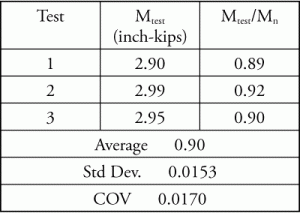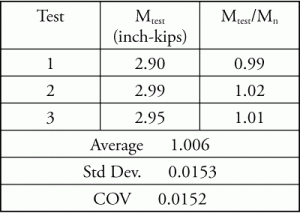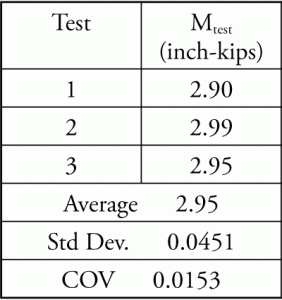Most typical nonstructural partitions are specified and constructed in accordance with the industry or manufacturers’ design tables and would not require additional, formal engineering input on a project-by-project basis. The manufacturers’ design tables are based on engineering principles and tests. However, there are projects where the requirements are outside the limits of the manufacturers’ design tables.
The North American Standard for Cold-Formed Steel Framing – Nonstructural Members (AISI S220) was developed in 2011 by the AISI Committee on Framing Standards to help clearly delineate and eliminate confusion between the engineering principles and requirements for cold-formed steel structural members and nonstructural members. As such, provisions formerly in North American Standard for Cold-Formed Steel Framing – General Provisions (AISI S200) for material, corrosion protection, base steel thickness, product designators, manufacturing tolerances, product identification, member design, member condition, installation, connections, and miscellaneous for nonstructural members were moved to AISI S220. However, use of the more stringent requirements for structural members that are in AISI S200 for nonstructural members should be permitted, since these should demonstrate at least equivalent performance for the intended use to those specified in AISI S220.
AISI S220 recognizes that the consequence of failure for a nonstructural member is less severe than for a structural member and, consequently, permits a lower reliability for nonstructural members.
What is a Nonstructural Member?
The previous standards when defining a nonstructural member are focused on wall assemblies, as defined in the following descriptions.
ASTM C645 Standard for Nonstructural Steel Framing Members
A member in a steel framed wall system which is limited to a transverse (out-of-plane) nominal load of not more than 10 lb/ft2 (0.48 kPa), a superimposed nominal axial load, exclusive of sheathing materials, of not more than 100 lb/ft (1.46 kN/m), or a superimposed nominal axial load of not more than 200 lbs (0.89 kN).
AISI S100 [CSA S136], North American Specification for the Design of Cold-Formed Steel Structural Members, 2007 Edition with Supplement 1
An interior partition wall stud in a composite steel framed interior wall system with sheathing attached to both flanges and that is limited to a transverse (out-of-plane) nominal load of not more than 10 lb/ft2 (0.48 kPa), a superimposed nominal axial load, exclusive of sheathing materials, of not more than 100 lb/ft (1.46 kN/m), or a superimposed nominal axial load of not more than 200 lbs (0.89 kN).
AISI S200, North American Standard for Cold-Formed Steel Framing – General Provisions, 2007 Edition
A member in a steel framed system which is limited to a transverse(out-of-plane) load of not more than 10 lb/ft2 (0.48kPa), a superimposed axial load, exclusive of sheathing materials, of not more than 100 lb/ft (1.46 kN/m), or a superimposed axial load of not more than 200 lbs (0.89 kN).
However, the nonstructural profile is often used in interior fascia and ceiling construction. Also, burying numeric requirements in a definition was considered poor standards’ writing.
During the development of AISI S220 and companion 2012 revision of AISI S200, the definition of nonstructural member was generalized to include other nonstructural members such as those used in interior fascia and ceiling construction:
Nonstructural Member. A member in a steel-framed system that is not a part of the gravity load resisting system, lateral force resisting system or building envelope.
The numeric load limitations were retained and moved to the Scope section of AISI S220. However, it is important to note that the nonstructural member definition now applies to broader applications.
Design Approaches
Historically, the nonstructural wall assembly has been load tested in accordance with ICC-ES AC86 to define the strength and stiffness of the cold-formed steel wall stud acting within a composite assembly that included the gypsum wallboard. Load tables presented the design capacity of the composite wall assembly, which were based on a safety factor of 1.5.
Although the composite wall assembly offered economic advantages, design conditions also often required the nonstructural member to be designed acting non-composite with the sheathing material. Examples of non-composite design conditions are ceiling framing, interior fascia framing, or partition walls with sheathing on one side only. Historically, assemblies using the non-composite assembly design approach were designed neglecting the composite-action contribution of the attached sheathings based on the design provisions of AISI S100. Thus, a safety factor of 1.67 for a bending member or 1.8 for an axial loaded member was imposed.
AISI S220 has addressed the inconsistency in the safety factors for composite and non-composite assemblies. AISI S220 recognizes that the consequence of failure for a nonstructural member is less than for a structural member and, consequently, permits a lower safety factor or greater phi factor for nonstructural members.
Equivalent Thickness Sections
Historically ASTM C645, Table 2, has stipulated minimum section properties for the nonstructural member. Included was the design property, Mn/Ω, and the minimum base steel thickness.
ASTM C645 Section 4.3 stated: “Members shall be manufactured from steel having a minimum thickness, individual measurement of 0.0179 inches before application of protective coating.”
The minimum base steel thickness was given, which was based on meeting the width-to-thickness ratios of Chapter B of AISI S100.
However, ASTM C645 Section 9.2 permitted nonstructural profiles to have thickness values less than 0.0179 inches: “Members that can show third party testing in accordance with ICC-ES-AC86 and conform to the limiting heights tables in Specification C754 need not meet the minimum thickness limitation set forth in Section 4.3 or the minimum section properties set forth in 8.1”
The minimum section properties in Section 8.1, for example Mn/Ω as listed in Table 2, were computed using AISI S100 with Fy of 33 ksi.
To achieve more economical design solutions, manufacturers have developed proprietary cross sections that are thinner than 0.0179 inches, but have achieved the Mn/Ω required by ASTM C645 by using higher yield strength materials. These proprietary cross sections have been labeled equivalent thickness, i.e. EQ, sections. They possess the requisite Mn/Ω but are thinner than 0.0179 inches.
For this reason, AISI S220 does not include a minimum thickness requirement.
Member Design
Because nonstructural members typically are relatively thin, they often do not meet the various dimensional (i.e., slenderness) limitations prescribed by Section B1 of AISI S100. Thus, the provisions of Chapters B and C are often not directly applicable.
To facilitate design of the nonstructural member sections both meeting and not meeting the Section B1 requirements, the following provisions have been adopted into AISI S220 for both the non-composite and composite assembly applications.
Non-composite Assemblies
A non-composite assembly is defined as an application wherein the design that neglects the contribution of the attached sheathing to either the strength or stiffness. AISI S220 provides the following options when designing a non-composite assembly:
“(i) Design using Chapters A through E of AISI S100 [CSA S136] with:
ΩN = 0.9 Ω
φN = 1.1 φ
where
Ω = Safety factor per relevant section of AISI S100 [CSA S136]
φ = Resistance factor per relevant section of AISI S100 [CSA S136]”
To employ the above provision, the cross-section profile must meet all dimensional and ductility limitations imposed by AISI S100. The traditional nonstructural 3-5/8-inch depth C-section wall stud having a thickness equal to or greater than 0.0179 inches could utilize this provision. Traditionally, a 10 percent reduction in the omega factor or a 10 percent increase in the phi factor has been permitted for the composite wall assemblies. This reduction or amplification factor has been extended to the nonstructural assembly in AISI S220.
For a section not meeting either the dimensional limitations of AISI S100 Section B1 or ductility limitations of AISI S100 Section A1.2, physical tests or rational analysis is to be employed. Thus, AISI S220 requires the following when tests alone are utilized to define the member’s strength:
“(ii) Chapter F of AISI S100 [CSA S136] with:
β0 = 1.6
where
β0 = Target Reliability Index in accordance with Section F1.1(b) of AISI S100 [CSA S136]
Ω = Safety factor per Section F1.2 of AISI S100 [CSA S136]
φ = Resistance factor per Section F1.1(b) of AISI S100 [CSA S136]”
It is noteworthy that the above provision will result in an omega of approximately 1.5 or a phi factor of approximately 1.0. Thus a safety factor consistent with the traditional safety factor used for a composite wall assembly is achieved.
For a section not meeting either the dimensional or ductility limitations of AISI S100 and rational analysis per Section A1.2, the safety factor, Ω, is 2.0 and the φ is 0.8. However, if tests are used to validate the rational analysis, AISI S220 permits the following:
“If Section A1.2(b) of AISI S100 [CSA S136] is utilized then supplementary tests are permitted to be performed and Chapter F of AISI S100 [CSA S136] is permitted to be employed for determination of Ω or φ, with Pm replaced by Ptest/Pcompute and β0 in accordance with the provisions above.
In the use of AISI S100 [CSA S136] Chapter F, the professional factor, P, shall be the test-to-predicted ratio where the prediction is that of the rational engineering analysis method selected, Pm is the mean of P and VP, the coefficient of variation of P. At least three tests shall be conducted.”
Composite Assembly
A composite assembly is as a wall stud application wherein the design reflects the contribution of the attached sheathing to either the strength or stiffness of the wall stud. AISI S220 provides the following guidance when designing a composite assembly:
“(b) Composite Assembly Design –Assemblies using a composite assembly design approach shall be designed based on the tests undertaken and evaluated in accordance with Chapter F of this standard.”
For cold-formed steel nonstructural members in interior nonload bearing wall assemblies, ICC-ES AC86, Acceptance Criteria for Cold-Formed Steel Framing Members – Interior Nonload-Bearing Wall Assemblies, is generally an approved test method.
Connection Design
Connection design is in accordance with AISI S100 [CSA S136] or testing in accordance with Section F1 of AISI S100 [CSA S136]. Additional design guidance is provided in Chapter D of AISI S220 regarding screw installation, stripped screws, spacing and edge distance of screws and attachment of gypsum board.
The standard does not mention the penetration test for screws, i.e. the procedure for evaluating the member’s ability to pull the head of a screw below the surface of gypsum sheathing, which is addressed by ASTM C645 Section 10. Therefore, building code provisions continue to require compliance with ASTM C645 Section 10.
Illustrative Examples
Using fictitious test data for Mtest/Mn, the intent of the following example problems is to illustrate the application of Section B1of AISI S220. The examples illustrate the application of the various non-composite assembly design provisions.
Given: 362S125-152
Design thickness = 0.016 inch (0.0152 inch/0.95 per AISI S100 Section A2.4)
Fy = 50 ksi
Inside bend radius = 0.030 inch
Edge stiffener = ¼ inch
Mn = 3.26 inch-kips computed per AISI S100, Chapter B and Section C3.1.1 (Note: This calculation ignores the fact that the width-to-thickness ratios violate Section B1.)
(a) Example 1 [Rational Analysis with Supplementary Tests] – Using AISI S220 Section B1(a)(ii). For this situation, the design cannot be performed by AISI S100 Chapters B through E because the width-to-thickness ratios violate Section B1. Thus, AISI S100 Section A1.2(b), rational analysis along with supplementary tests is applied. The rational analysis determines that Mn = 3.26 inch-kips, based on the engineering judgment that the equations in AISI S100, Chapter B and Section C3.1.1 can be used. The safety factor and phi factor are computed using AISI S220 Section B1(a)(ii).
Based on the Mtest/Mn ratio, with Mn computed using AISI S100 Chapters B and C as a rational analysis results in an average 10% over estimation of the cross-section moment capacity. Thus, using AISI S100 as the rational analysis and based on the test results, the design moment capacity is the value determined by rational analysis; i.e., 3.26 inch-kips, with the following:
Ω = 1.68
φ = 0.96
The Ω and φ were computed using Chapter F of S100 with β0 = 1.6
(b) Example 2 [Rational Analysis with Supplementary Tests]–Using AISI S220 Section B1(a)(ii). For this situation, the design cannot be performed in by AISI S100 Chapters B through E because the width-to-thickness ratios violate Section B1. Thus, AISI S100 Section A1.2(b), rational analysis along with supplementary tests is applied. The rational analysis determines that Mn = 2.93 inch-kips , based on the engineering judgment that the equations in AISI S100, Chapter B and Section C3.1.1 result in an average 10% over estimation of the cross-section moment capacity. The safety factor and phi factor are computed using AISI S220 Section B1(a)(ii).
Because supplementary tests were performed in combination with using Chapter B and Section C3.1.1, a reasonable rational analysis, the design moment capacity is the value determined by rational analysis; i.e., 2.93 inch-kips (0.331 kN-m), with the following:
Ω = 1.50
φ = 1.07
The Ω and φ were computed using Chapter F of S100 with β0 = 1.6
(c) Example 3 [Rational Analysis without Supplementary Tests] – Not using AISI S220 Section B1(a)(ii). For this situation, the design cannot be performed by AISI S100 Chapters B through E because the width-to-thickness ratios violate Section B1. Thus, AISI S100 Section A1.2(b) is being applied without supplementary tests. The safety factor and phi factor are defined by AISI S100 Section A1.2(b).
Because supplementary tests were not performed and a rational analysis using AISI S100 Chapter B and Section C3.1.1 had been adopted, Mn = 3.26 inch-kips and the following factors, per Section A1.2(b) of S100 would apply:
Ω = 2.0
φ = 0.80
(d) Example 4 [Tests without Rational Analysis]–Using AISI S220 Section B1(a)(ii). For this situation the design cannot be performed in by AISI S100 Chapters B through E because the width-to-thickness ratios violate Section B1. Thus, AISI Section A1.2(a) is being applied. The safety factor and resistance factor are computed using AISI S100 Chapter F.
The design value is the average tested value of 3.29 inch-kips with the following:
Ω = 1.51
φ = 1.06
The Ω and φ were computed using Chapter F of S100 with β0 = 1.6
Conclusion
AISI S220, North American Standard for Cold-Formed Steel Framing – Nonstructural Members, was developed in 2011. It clearly delineates and eliminates confusion between the requirements for cold-formed steel structural members and nonstructural members. It provides a level playing field for cold-formed steel manufacturers to develop new, efficient products for nonstructural applications.▪
Acknowledgements: The authors express their appreciation to the members of the AISI Committee on Framing Standards and its Nonstructural Task Group for their support and cooperation during the development of AISI S220.



